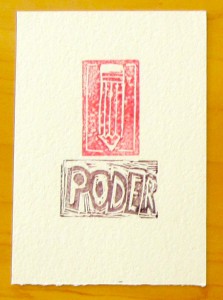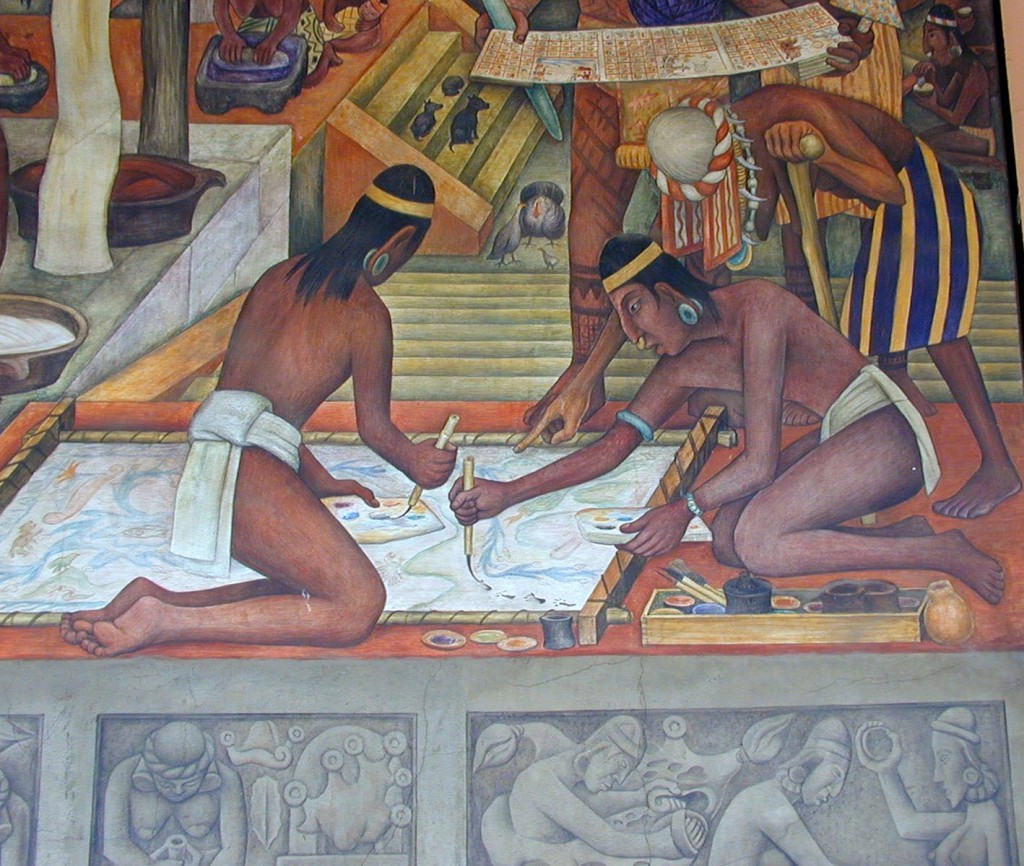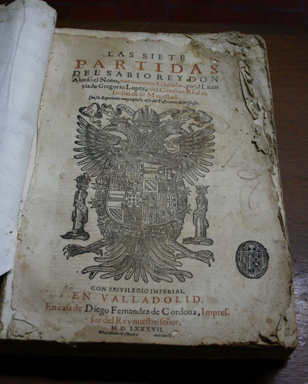On this page we are assembling materials that relate to codices in that they help us understand indigenous language use and its evolution, including writing systems. In the Nahuatl language and perhaps in others, the words relating to both writing and painting were the same.
Pre-Columbian Writing Systems
- Zapotec
- Javier Urcid, “Zapotec Writing: Knowledge, Power, and Memory in Ancient Oaxaca” (FAMSI)
- Zapotec (with examples of glyphs; from AncientScripts.com)
- Short video clip on Monte Albán stone carvings by Gabriela Martín
- WHP’s Zapotec Dictionary (under development)
- Mixtec
- Codex Nuttall (Mixteca Alta) (in digital facsimile), hosted by Mesolore. This codex was possibly made around 1500, prior to the European invasion of the American mainland in what is now Mexico.
- WHP’s Mixtec Dictionary (under development)
- Nahuatl
- R. Joe Campbell and Frances Karttunen, Foundation Course in Nahuatl Grammar, Volume I, Part I; Volume I, Part II; Volume II (whole volume in one PDF)
- Gordon Whittaker, “The Principles of Nahuatl Writing“
- Alfonso Lacadena, “Regional Scribal Traditions: Methodological Implications for the Decipherment of Nahuatl Writing” (Mesoweb, 2008)
- The Matrícula de Tributos, or Register of Tributes, offered here in digital facsimile, seems to date from the first half of the sixteenth century. It has Spanish-language explanations added to it, but it gives us a strong idea of Nahua writing and documents prior to contact. It was made on amatl (prehispanic paper). Hosted by Mesolore.
- Felipe Fernández-Armesto on Aztec writing (Mexicolore)
- Mexicolore’s “Aztec Books: An Introduction” (Julia Flood)
- Mexicolore’s “Aztec Calendar(s)” (Ian Mursell)
- “Cosmogonía mesoamericana: arte y ceremonia mexica” (in Spanish) features a Nahua codex (the “Borbonicus”) in a 4:30 min. documentary with animation.
- Aztec (a.k.a. Nahuatl; with examples of glyphs; from AncientScripts.com)
- Nahua glyph deciphering exercise (by Stephanie Wood; PDF format)
- Nahua glyph counting decipherment, Códice Kingsborough (by Stephanie Wood, PDF)
- Nahuatl glyphs (names of two Tetzcocan kings)
- Mayan
- Maya glyph deciphering exercise (by Stephanie Wood, adapting an exercise by Marc Zender; Word docx format; after clicking on the link, check your downloads folder for the file)
- Nova’s Cracking the Maya Code — This is the PBS program that narrates the recent progress made in deciphering Maya glyphs. A Nova websites provides a preview from the documentary, plus educational supplements such as a description of the TV program, recommended links and books, a teacher’s guide, ”Time Line of Decipherment,” “A Masterpiece Revealed” (about a mural), “Decode Stela 3” (details with audio), a “Map of the Maya World,” and “Speaking Ancient Maya” (a podcast about the language of the ancient people). One can also stream the program, chapter by chapter, from this web page. Cracking the Maya Code is also available in seven parts in YouTube and in a full version, with advertisements at the start.
- Video of a lecture “Sesenta años descifrando la escritura maya,” by Galina Ershova, 2012 (hosted by Universidad Francisco Marroquín, Guatemala, 1 hour, 16 minutes).
- WHP’s Yucatec Mayan Dictionary (under development)

NEH Summer Scholar (2010) Pearl Lau has her art students carve Maya glyphs in bars of soap. (Photo, P. Lau, 2014)
- P’urhépecha
- WHP’s P’urhépecha Dictionary (under development)
- Other Languages
- There are a great many additional indigenous languages of Mesoamerica, not just for Mexico, but for Guatemala, Honduras, Nicaragua, El Salvador, and Belize. We are just providing a selection here, but we encourage you to look into additional languages of your choice. The people of Oaxaca, alone, speak fifteen different indigenous languages. Perhaps 30% of the population of the state of Oaxaca speaks an indigenous language.
Colonial Language Records
- “Introduction to the Alvarado Vocabulario” (Mixtec vocabulary from the Spanish colonial period), hosted by Mesolore.
- “The Alvarado Vocabulario,” more about the Mixtec vocabulary (in digital facsimile), hosted by Mesolore.
- Codex Selden (Mixteca Alta) (in digital facsimile), hosted by Mesolore. Compare this one, from about 1560, with the Mixtec codex, above, from about 1519. Note the remarkable continuity in iconography two generations after Spanish colonization (if we can trust the dating methods).
- Ñuudzavui Geographies (a variety of colonial and modern resources relating to the Mixteca Alta and its history, free in PDF, hosted by Mesolore.
- “The Molina Vocabulario” of colonial Nahuatl (in digital facsimile), hosted by Mesolore.
Indigenous Language Use and Evolution
- Justice: Mixtec Language (2009; video, 5 minutes, on YouTube) — in Spanish and Mixtec but with English subtitles, this brief dramatization shows acts of discrimination but ends with a message about cultural pride
- Interview in Spanish with linguist Michael Swanton, “El Coloquio de Lenguas Otomangues en Oaxaca,” (video, 8 minutes); discussing a meeting in 2010 in support of indigenous languages and their collaborative study (indigenous/non-indigenous), with particular attention to the Otomanguean language family, which is so diverse, and references to the recent activity studying long-neglected indigenous-language manuscripts from the colonial period, especially in Nahuatl; regarding modern indigenous language promotion and which orthography to promote, Swanton argues that those who are most productive and most widely-read will be the ones who set the standards today for writing their languages; he also urges creative production in indigenous-language film, poetry, music, and hopes many indigenous philologists will step up to study older manuscripts
- Interview in Spanish with historian/scholar Bas van Doesburg, “Textos del periodo colonial escritos en lengua indígena” (video, 8 minutes)
- Interview in Spanish with historian/scholar Michel Oudijk, “El valor de los textos escritos en lenguas indígenas” (video, 10 minutes)
- Interview in Spanish with art historian Marina Garone Gravier, “Las publicaciones en lenguas indígenas del periodo colonial“) (video, 9 minutes)
- “La lengua zapoteca hoy,” lecture in Spanish by Javier Castellanos Martínez, prize-winning author of modern Zapotec literature (YouTube video, 15 minutes)
- “Isthmus Zapotec: Language, Memory, and Identity” — part of the larger ESRI map interactives about endangered languages
- “Lengua y cultura zapoteca,” lecture in Spanish by Hugo Miranda Segura about the challenges in modern educational settings for indigenous children (YouTube video, 15 minutes)
- Mexicolore’s “Aztec Voices across the Centuries” (Frances Karttunen) examines the evolution of the writing system before and after contact with Europeans, along with changes in pronunciation
- Mexicolore’s “Aztec Placenames then and Now” (Frances Berdan) explores place glyphs but also the elements that make up placenames, a reflection of what was important to Nahuas as they named their communities and landscapes
- Náhuatl Borrowings from Spanish (Frances Karttunen) — through contact with Spanish, indigenous languages took in loans, often modified in spelling and pronunciation. These examples are found in Nahuatl.
- Early Nahuatl Library (Stephanie Wood and contributors)– this is a digital collection of alphabetic manuscripts in Nahuatl. Thousands of manuscripts remain from about the 1540s through the 1820s whereby indigenous writers kept records about daily life (testaments, bills of sale, petitions, etc.).
- Free online Nahuatl Dictionary — this resource, built by Wired Humanities Projects at the University of Oregon, as a collaboration between scholars in the U.S. and Mexico (especially John Sullivan and team at IDIEZ), includes translations to English and Spanish of Nahuatl words from colonial times to the present. The language has evolved much as English is no longer just like Shakespearean English, and yet we can understand the older forms. Loanwords from Spanish are also included in this dictionary, as are examples of sentences pulled from colonial manuscripts written in Nahuatl.
- Many new resources have just come on line, hosted by partners in Nahuatl language, culture, research, and education in Poland!
- Here’s a very moving ten-minute speech by a Nahuatl-speaking girl whose family moved from Veracruz to Nuevo Léon, encouraging pride in indigenous heritage and Mexico’s multiplicity of ethnicities.
Spanish Language Writing and Literacy
Graffiti Calligraphy Today

A Swoon & Retna piece in Oaxaca. They covered the entire face of a building with this unique type of calligraphy. (Photo, Itandehui F. Orozco, 2013.)
See also this academic study of “calligraffiti,” including the incorporation of Arabic calligraphy. It is reminiscent of some of the examples from Oaxaca, above.
Curricula
Jessica Klonsky – 11th Grade Latino and Latin American Literature unit, “Pre-colonial Mesoamerican Writing” (2011)
- Unit Information (DOC)
- Is This Writing? (PPT)
- Pre-colonial Mesoamerican Writing Systems (PPT)
See also the various curricular units under the heading Codices.







